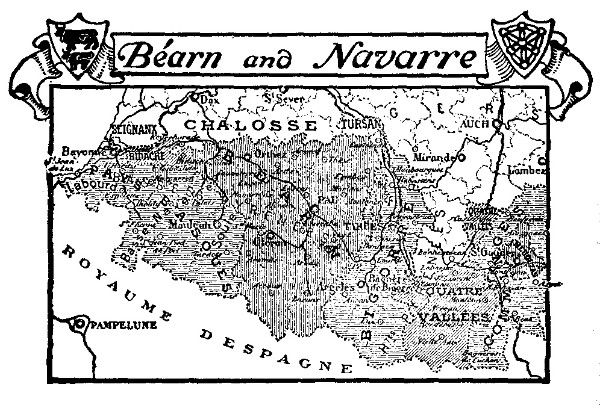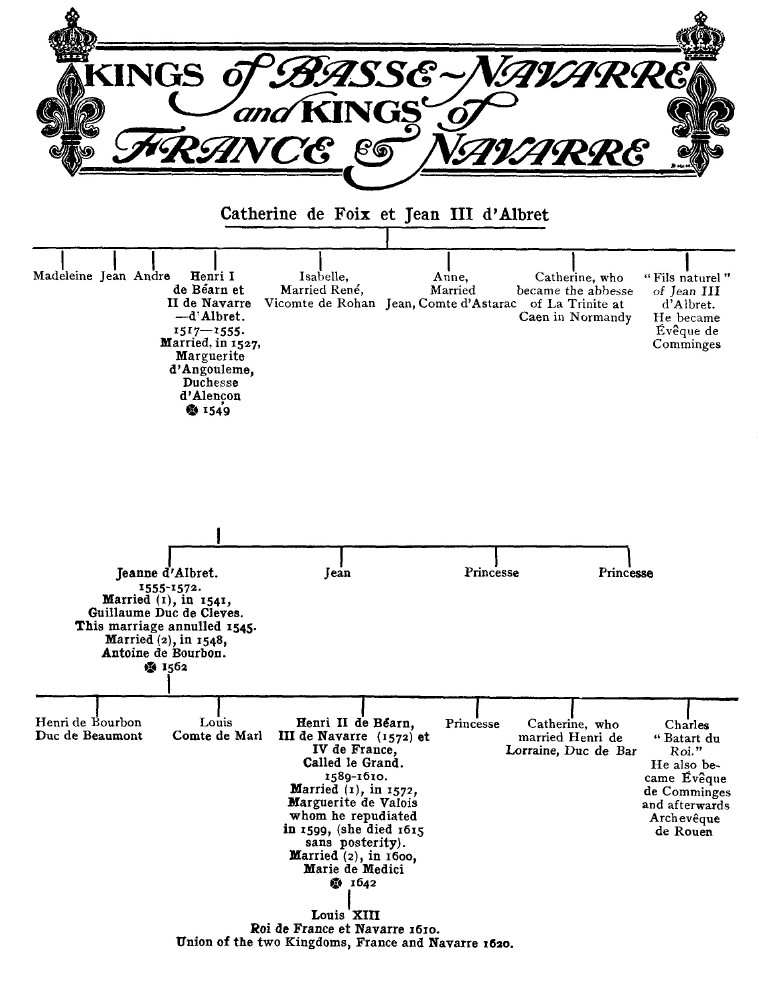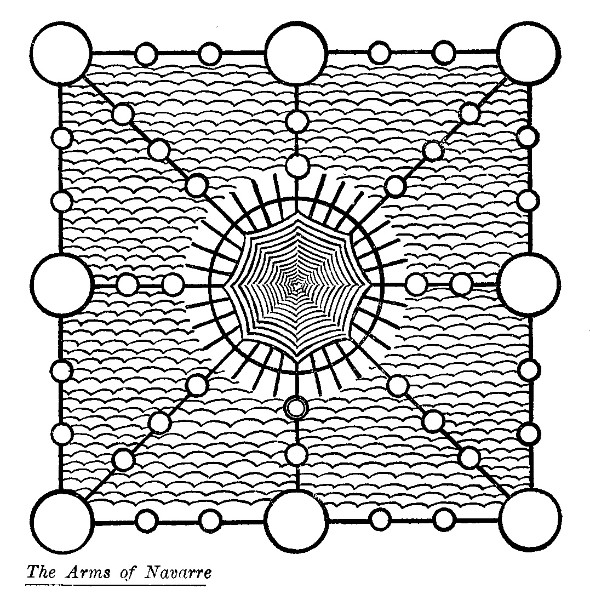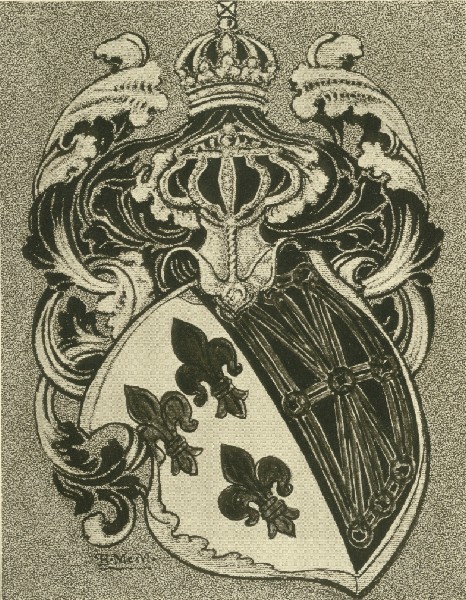| Web
and Book design,
Copyright, Kellscraft Studio 1999-2010 (Return to Web Text-ures) |
Click
Here to return to
Castles and Chateaux of Old Navarre and the Basque Provinces Content Page Return to the Previous Chapter |
 (HOME)
|
| CHAPTER XXIV
THE BIRTH OF FRENCH NAVARRE  BÉARN AND NAVARRE BASSE-NAVARRE or Navarre-Française, together with Béarn, made, under the Emperor Hadrian, a part of Aquitaine. The Roman conquest of Gaul was the first impetus given towards a coherent massing of the peoples. Formerly there had been many tribes and races, but the three divisions made by the Romans reduced things to a minimum. Cisalpine Gaul was that part where the inhabitants wore a sort of adaptation of the Roman toga. In Trans-Alpine Gaul, situated in the Rhône basin and along the Mediterranean between Italy and Spain, the inhabitants wore braies or bragues — a sort of jacket extending down almost to the knees, a detail of dress which has evolved itself into the blouse, and perhaps even the great cloak of the mountaineers of the Pyrenees. The remainder of ancient Gaul was known as the country where the natives wore their long hair hanging, — literally the Gaule chevelue. Through the times of Cæsar the divisions became indifferently known by various names, until with Augustus there came to be four great divisions, the Narbonnaise, Aquitaine, Lyonnaise and Belgique. Towards the fifth century the Vascons, or Gascons, the ancient inhabitants of Spanish Cantabria, established themselves snugly in these well protected valleys of the Pyrenees. They warred with the Saracens, and for five centuries were in a continual uproar of battle and bloodshed. Among themselves, the dukes and counts of Gascogne quarrelled continuously, and disputed the sovereignty of the country with the Vicomtes de Béarn. In the ninth century a treaty was consummated which assured to Bernard, Comte d'Armagnac, the Comté de Gascogne, and to Gaston de Centulle the suzerainty of Béarn, while Navarre came by heritage to the Comtes de Champagne, and in the thirteenth century to Philippe-le-Bel as a dot with Jeanne, his wife. In the same manner it came to the house of Evreux through Jeanne II, daughter of Louisle-Hutin. With the marriage of Blanche II, the granddaughter of Jeanne II, Navarre passed to the king of Aragon and to Eléonore, and later with the Comté de Foix et de Bigorre and the Vicomté de Béarn, went to Jean, Sieur d'Albret, with whom the history of the kingdom is so commonly associated. Jean d'Albret II, by reason of his marriage with Catherine of Béarn, the heiress to the crown of Navarre, became joint ruler of the kingdom. He was a gentle, easy-going prince, liberal, but frivolous, and loved no serious occupation in life. He was popular to excess and dined, say the chronicles, "without ceremony, with any one who asked him," a custom which still obtains with many who are not descendants of a king of Navarre. He danced frequently in public with the wives and daughters of his subjects, a democratic proceeding which was not liked by his court, who told him that he "danced on a volcano." This in a measure was true, for he lost that part of the kingdom known as Spanish Navarre to Ferdinand of Aragon. Up to the commencement of the sixteenth century, the Royaume de Navarre occupied both slopes of the Pyrenees and had Pamplona for its capital, but in 1512, Ferdinand the Catholic, of Aragon, with the approbation of the Pope, usurped most of the territory and left the king of Navarre, the legitimate sovereign, only a small morsel eight leagues long by five in width, with St. Jean-Pied-de-Porte as its principal city. A picturesque figure was Ferdinand, King of Aragon on his own part, King of Castille by his wife Isabella, and King of Grenada by conquest; "a heritor of three bastard crowns," he was called. At his death he was succeeded by the infamous and cruel Charles V. That which remained, French Navarre, was the portion of the united kingdom lying on the French slopes of the Pyrenees. The loss of the Spanish province was really due to the excommunication of Jean d'Albret and Catherine by the Pope, thus giving the Catholic Ferdinand power to compel a division. The then ruling monarchs of Béarn and Navarre came to a sad realization of their position. It was this circumstance which gave birth to one of the famous mots of history. "If we had not been born, we would not have lost Navarre," said the unhappy Catherine to her spouse. Previously, though, the region had been known as Basse-Navarre; and in Spanish, Navarra Baja, and had had its États or Parlément, and its own special laws. Its Partement was composed of three orders, the clergy, the noblesse and the tiers. Two great families stood out in Basse-Navarre in these times above all others, the Seigneurs de Grammont et Bidache and those of Lux and Ostabat. Béarn at the time was composed of twelve ancient baronies, the bishoprics of Lescar and Oloron, and the seigneuries of Navailles, Andoins, Lescun, Correze, Miossens, Arros and Lons. French Navarre — the Navarre-Française — was by this time a reality and has been variously known since to historians; to the French as Basse-Navarre and Navarre du Nord; to the Spaniards as Navarra Baja; to the Basques as Navarra-deca-ports, and Navarra-françia; and to the kings of France as the Royaume de Navarre. Henri, son of Jean d'Albret, married the first Marguerite de Valois, sister of François I, the "Marguerite of Marguerites." The only daughter of this marriage was wed with Antoine Bourbon-Vendome and became the mother of Henri IV. By an edict of 1620 Louis XIII united the crown of France with that of Navarre, Béarn and the other patrimonial states. Such is the evolution of the little Royaume de Navarre and its incorporation into French domain. The king of Navarre's title was a formidable one, and even included the word monsieur. Princes, bishops, popes and saints were at that time known as Monsieur, a title even more dignified than Monseigneur, and the "Messieurs de France" were as much of the noblesse of France as were the "Milords d'Angleterre" of the nobility of England. The full title of the king of Navarre in the fifteenth century was as follows: — Monsieur François-Phoebus, par la grace de Dien, Roi de Navarre, Duc de Nemours, de Guandi, de Montblanc et de Penafiel, et, par la même grace Comte de Foix, Seigneur de Béarn, Comte de Bigorre et de Rivegorce, Vicomte de Castelbon, de Marsau, Gavardan et Nébouzan, Seigneur de la ville de Valaguer et Pair de France. KINGS OF BASSE-NAVARRE AND KINGS OF FRANCE AND NAVARRE 
The arms of Navarre have ever been a mystery to antiquarians, but it seems there is some semblance of Basque tradition and folk-lore in it all, in that there is an old Basque game which is played upon a diagram, or scale, traced upon the ground, and following the principal outlines of the blazonings of the ancient kings of Navarre. Which came first, the hen or the egg?  THE ARMS OF NAVARRE Authorities differ, and so it is with the Basque game of laz Marellas, and the royal arms of the Navarres. Labastide says the game came down from the time when the Basques of today were originally Phoenicians. If this be so, the royal arms were but a copy of something that had gone before. Certainly they form as curious and enigmatic an armorial device as is found in heraldry. The Royaume de Navarre has so completely disappeared and been so absorbed by France that it takes a considerable knowledge of geography and history to be able to place it precisely upon the map of modern Europe, hidden away as it was in what are now the two arrondissements of Bayonne and Saint-Palais. They were a noble race, the men of Béarn and Navarre, the Basques especially, and the questionable traits of the cagots and gypsies have left but little impress on the masses. Henri IV, faithful in his sentiment for his first subjects, would have shown them his predilection by allowing them to remain an independent monarchy. He would not that the kingdom of his mother be mingled with that of France, but intriguing counsel prevailed and the alliance was made, though Navarre escaped conquest and was still ruled by the sceptre of its legitimate sovereign. How near France came to being ruled by Navarre instead of Navarre by France is recalled by the following bit of recorded history. When Philippe V (le Long) came to the throne of France (1316) his right was contested by many princes. Among others the crown was claimed by Jeanne de Navarre, but an assembly of bishops, seigneurs and bourgeois of Paris declared for the Salic law — which proscribed the right to rule the French to one of the female sex, and this against feudal rights as they were known and protected in the satellite kingdoms surrounding the royal domain. It was agreed later (by Philippe-le-Long) that if the widow of Louis X should have another female child, the rights appertaining to Navarre should belong to her and her stepsister Jeanne, making' it an independent monarchy again. When Philippe-le-Bel came to the throne of France it was his wife Jeanne who, by common consent, administered the affairs of Navarre. She chased the Aragonians and Castilians from her fair province, and put her people into a state of security hitherto unknown. "She held," said Mézeray the historian, "every one enchanted by her eyes, her ears, and her heart, and she was equally eloquent, generous and liberal." A veritable paragon of a woman evidently. Henri II, son of Catherine and Jean d'Albret II, succeeded to the throne of French Navarre at the age of thirteen. He followed the French king, François, to Italy, and was made prisoner at the unfortunate battle of Pavia, finally escaping through a ruse. François Premier, king of France, and Henri d'Albret, king of Navarre, each nourished an equal aversion for the king of Spain, the prime cause of that fateful day at Pavia. The first hated the Spanish monarch as a rival; the second as the usurper of his lands. They united arms, but the battle of Pavia, when "all was lost save honour," gave matters such a setback that naught but time could overcome them. It was Henri II's marriage with Marguerite of Valois, the Duchesse d'Alençon, in 1526, by which he acquired the Armagnac succession as a gift from his brother-in-law, François Premier, that brought to Navarre's crown nearly all of Guyenne. In 1555 the young king died at Pau, leaving a daughter, Jeanne d'Albret, who with her second husband, Antoine de Bourbon, Duc de Vendome, succeeded to the throne. The new rulers did not attempt or accomplish much, save to embrace Calvinism with zeal. Suffice to recall the well-known facts that Antoine died in 1562 from a wound received in the siege of Rouen, and that Jeanne herself died from the poison of the wicked Catherine de Medici's gloves at Paris. Their son, Henri III of Navarre, was the Henri IV of France. Born at Pau in 1553, he was first only the Comte de Viane. When he came to Paris he would not have allied his Pyrenean possessions with those of France but for the pressure brought to bear upon him. He declared that his ancestral lands should remain entirely separate, but the procureur general, La Guesle, forced his hand, and it was thus that the Royaume de France became augmented by Basse-Navarre, the Comtés d 'Armagnac, Foix, d 'Albret and Bigorre, the Duché de Vendome, the Comté de Périgord and the Vicomté de Limoges. The story of Béarn and Navarre, for most folk, begins with those kings of Navarre who were also kings of France. The first of these was the white-plumed knight Henri III, Prince of Béarn, who became Henri IV of France. The France of the Valois, which strain died with Henri III, murdered by the black monk Clement, was much more narrow in its confines than now. In the northeast it lacked Lorraine, Franche Comté, Bresse, Dombes and Bucey; in the south Roussillon, Béarn and Basse-Navarre, and there was a sort of quasi-independence observed by the former great states of Bretagne, Bourgogne and Dauphiné. With the coming of the king of Navarre to the throne of France, the three great movements which took place in the religious situation, the manners and customs of the court and noblesse, and in the aspirations of the people gave an aspect of unity and solidarity to France. The religious question was already momentous when Henri IV was crowned, and Protestantism and its followers were gaining ground everywhere, though the real Français — the Guises and the Bourbons, the princes of Lorraine and the "princes of the blood" — were on the side of Catholicism, and had their swords ever unsheathed in its behalf. The court, in the midst of this great religious quarrel, was also in a state of transition. Catherine and her gay troupe of damsels had passed, as also had Charles IX, who died shortly after the Huguenot massacre of St. Bartholomew's night. His brother, and successor to the throne, Henri III, Duc d'Anjou, was a weakling, and he too died miserably at the point of the assassin's knife, and few seemed to regret the passing of him who devoted himself more to monkeys, parrots and little dogs than to statecraft. Henri of Béarn was the strong man in public view, and of him great things were expected by all parties in spite of his professed Calvinism of the time. It was during the reign of the feeble-witted Henri III that Henri, king of Navarre, became the titular head of the Huguenots; thus abjuring the Catholic religion that he had previously embraced under pressure. The Protestant League became a powerful institution, and the gentilshommes of Béarn, Guienne, Poitou and Dauphiné became captains in the cause, just as the gentilshommes of Picardie and Artois became captains of Catholicism. The whole scheme was working itself out on traditional hereditary lines; it was the Protestantism of the mountains against the Catholicism of the lowlands. As for the people, the masses, they simply stood by and wondered, ready for any innovation which augured for the better. This was the state of France upon the coming of Henri IV to the throne, and the joining of Basse-Navarre and Béarn to the royal domain.  THE ARMS OF NAVARRE Unquestionably it is a fact that the feudality in France ceased only with the passing of Louis XI, and the change in the Pyrenean states was contemporary. The Renaissance made great headway in France, after its importation from Italy at the hands of Charles VIII and his followers. Constantinople had been taken; art and letters were everywhere in the ascendency; printing had been invented; and America was on the verge of being discovered. The golden days of the new civilization were about dawning. The Renaissance here in Béarn and Navarre, under the shadow of the Pyrenees, flowered as it did nowhere else out of Italy, so far as its application to life and letters went. Many celebrated litterateurs and poets had been persecuted and chased from France, and here they found a welcome refuge. To remark only two, Desperriers and Marat, it is interesting to note that the sympathetic Marguerite of Navarre took them under her patronage, and even made them valets de chambre. Marguerite's passions were, according to the historians, noble, but according to the romancers they were worldly. Said Erasmus: "Elle était chaste et peu sujette max pass-ions," and contemporary historians agree with him; while Marat, the poet valet de chambre, wrote the following: — "Que
je suis serf d'un monstre fort étrange,
Monstre je dis, car pour tout vrai, elle a Corps féminin, coeur d'homme et téta d'ange." In 1574 Brantome, the chronicler, had finished his military career and was retained by Henri III of France as a gentleman of the bedchamber. Here he passed through many affairs of intrigue and the heart. In 1581 he received a mission to go and interview the king of Navarre, for which he received the sum of six hundred écus soleil. What the subject of this mission was no one knows; there is no further mention of it either in the works of Brantôme or the letters of the king of Navarre, but at any rate he became enamoured of Marguerite, and his account of his first meeting with her is one of the classic documents of French history. "I dare to say," said he, "that she was si belle et si admirable that all the three hundred persons of the assembly were ravished and astounded." It is on Marguerite of Navarre, no less than on the plumed Henry, that the popular interest in Navarre and its history has been built. A Brief Chronology of French and Spanish Navarre Spanish Navarre came to be annexed to the Spanish crown in 1512 through the efforts and energies of Ferdinand the Catholic king of Aragon. French Navarre virtually came to France in 1328, but its independent monarchs since that time have been:
It was Henri III of Navarre who became Henri IV of France and it was he who first brought the little kingdom to the crown of France, the double title being borne by his successors up to the abdication of Charles X in 1830. |